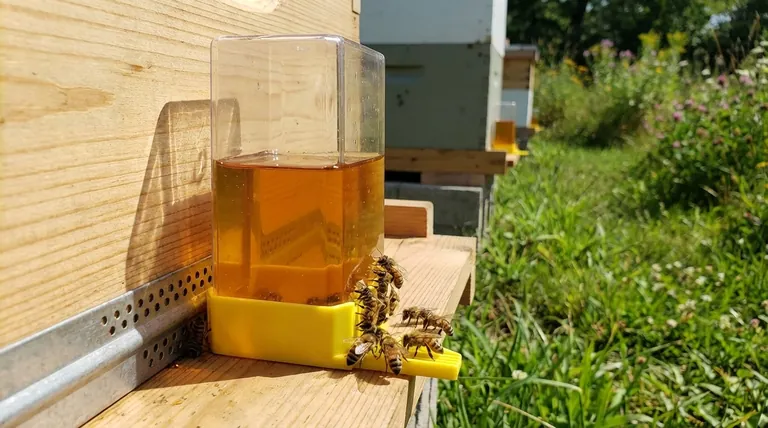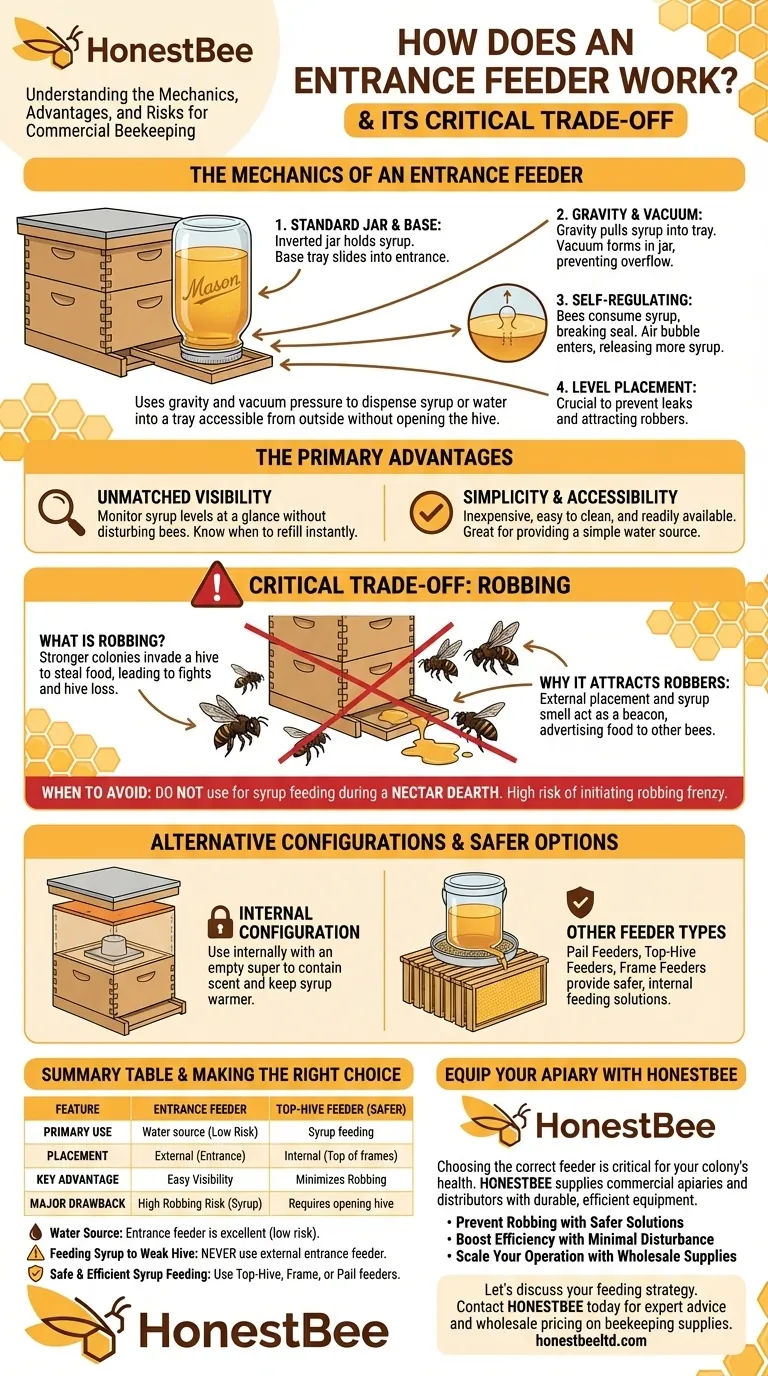At its core, an entrance feeder works by using a combination of gravity and vacuum pressure. A jar filled with syrup sits outside the hive and screws into a base tray that slides into the hive’s entrance, allowing the syrup to drip into the tray where bees can access it without leaving the hive.
While its simplicity and visibility are appealing, the entrance feeder's core design flaw is its external placement, which can advertise food to other colonies and create a significant risk of robbing.

The Mechanics of an Entrance Feeder
An entrance feeder, often called a Boardman feeder, is one of the most basic designs available to beekeepers. Its operation relies on a few simple principles.
The Core Components
The feeder consists of two main parts: a standard jar (like a Mason jar) that holds the liquid feed and a plastic or wooden base. This base has a trough that slides into the hive entrance and a screw-top receptacle to hold the inverted jar.
How Gravity and Vacuum Work Together
When you invert the full jar onto the base, gravity pulls a small amount of syrup into the feeding tray. As the syrup fills the tray, it creates an airtight seal that establishes a vacuum inside the jar. This vacuum prevents the rest of the syrup from pouring out.
As your bees consume the syrup from the tray, they break the seal momentarily, allowing a small air bubble into the jar. This releases the vacuum just enough for more syrup to flow down and refill the tray, creating a self-regulating system.
Proper Placement and Setup
To use an entrance feeder, you fill the jar with syrup, securely attach the base, and slide the tray into the hive’s main entrance. It is crucial to ensure the feeder is level to prevent steady leaking, which wastes syrup and is highly attractive to robber bees.
The Primary Advantages
The design of the entrance feeder offers two clear benefits, particularly for new beekeepers.
Unmatched Visibility
Because the jar is entirely outside the hive, you can see the syrup level at a glance. This allows you to monitor your colony's consumption rate and know exactly when to refill the feeder without opening the hive and disturbing the bees.
Simplicity and Accessibility
Entrance feeders are inexpensive, readily available, and easy to clean. Their straightforward design makes them a common entry point for beekeepers learning to supplement their colonies' food stores.
Understanding the Critical Trade-off: Robbing
Despite its simplicity, the entrance feeder has one major drawback that requires serious consideration.
What is Robbing?
Robbing is when bees from other, often stronger, colonies discover a hive's food source and invade to steal it. This can lead to a fight that decimates the weaker colony's population and can result in the complete loss of the hive.
Why Entrance Feeders Attract Robbers
The feeder’s position at the hive entrance makes any spilled or dripping syrup an open invitation. The smell of the sugar syrup acts as a powerful beacon, advertising a free meal to any bees in the area and guiding them directly to the weakest point of defense: the entrance.
When to Avoid This Feeder
This feeder is not recommended for feeding syrup during a nectar dearth (a period when natural nectar sources are scarce), which is often when colonies need feeding the most. Using it at these times significantly increases the risk of initiating a robbing frenzy. It is, however, considered much safer for providing a simple water source.
Alternative Configurations and Better Options
Understanding the risks of an entrance feeder allows you to make better choices for your hive's health.
An Internal Configuration
Some beekeepers use the same Boardman feeder internally to mitigate robbing. This involves placing an empty hive box (a super) on top of the inner cover, placing the feeder over the inner cover's hole, and then replacing the outer cover. This keeps the syrup's scent contained within the hive and also helps keep the syrup warmer.
Considering Other Feeder Types
For feeding syrup, other designs are generally considered safer and more efficient. Pail feeders, for example, sit on top of the hive frames and use vacuum pressure to dispense syrup slowly through a screen, minimizing leaks and keeping the food source protected deep inside the hive.
Making the Right Choice for Your Goal
Selecting a feeder depends entirely on your specific objective and the time of year.
- If your primary focus is providing a convenient water source: The entrance feeder is an excellent, low-risk tool for the job.
- If your primary focus is feeding syrup to a weak hive: Never use an entrance feeder externally, as it puts the colony at extreme risk of being robbed out.
- If your primary focus is safely and efficiently feeding syrup: A top-hive feeder, frame feeder, or pail feeder is a far superior and safer choice.
Choosing the right tool requires understanding both its function and its potential impact on your colony's ecosystem.
Summary Table:
| Feature | Description |
|---|---|
| How It Works | Uses gravity and vacuum pressure to dispense syrup from an external jar into a tray at the hive entrance. |
| Primary Use | Best for providing a water source. High risk for feeding syrup during a nectar dearth. |
| Key Advantage | Easy visibility of syrup levels without opening the hive. |
| Major Drawback | High risk of attracting robber bees, which can decimate a weak colony. |
| Safer Alternative | Top-hive feeders (e.g., pail feeders) keep syrup inside the hive, minimizing robbing. |
Equip Your Apiary with the Right Tools from HONESTBEE
Choosing the correct feeder is critical for your colony's health and productivity. The wrong choice can lead to robbing and hive loss. At HONESTBEE, we supply commercial apiaries and beekeeping equipment distributors with the durable, efficient equipment needed for success.
We provide a full range of feeding solutions, including safer top-hive and frame feeders, to help you:
- Prevent Robbing: Protect your investment by keeping food sources secure.
- Boost Efficiency: Feed your colonies effectively with minimal disturbance.
- Scale Your Operation: Reliable, wholesale-focused supplies for commercial beekeeping.
Let's discuss the best feeding strategy for your operation. Contact HONESTBEE today for expert advice and wholesale pricing on beekeeping supplies.
Visual Guide

Related Products
- Professional Hive Front Entrance Bee Feeder
- Boardman Entrance Bee Feeder Durable Galvanized Steel and Wood Construction for Beekeeping
- HONESTBEE Entrance Bee Feeder Professional Hive Nutrition Solution for Beekeeping
- HONESTBEE Entrance Bee Feeder Efficient Hive Front Liquid Feeding Solution for Beekeeping
- Classic Boardman Entrance Bee Feeder Hive Front Feeding Solution
People Also Ask
- What are entrance feeders, and where are they located? A Guide to External Hive Feeding
- How does the entrance feeder method work? A Guide to Simple But Risky Hive Feeding
- How does a beehive entrance feeder work? A Simple Guide to Supplemental Feeding
- How is the mesh ladder and barrier installed in the feeder box? A Step-by-Step Guide to Prevent Bee Drowning
- How do you make an entrance feeder for bees? A Guide to Safe & Effective Hive Feeding



















